Cory Huff's Blog: The Abundant Artist Goodreads blog, page 13
March 27, 2019
How to Sell Your Artwork With Words and Images
Artists are creative people. But in today’s crowded market where anyone can call themselves an artist, you have to try and cut through the noise. Creating beautiful works of art is no longer enough, you have to adapt yourself from being creator and maker to being a marketer and sales person. This means that you are in charge of your own promotion online and off line, you are doing your own admin and books and you are constantly looking for new opportunities to show your work. The actual art creation is becoming a smaller and smaller part of what you do.
The good news is that with so many online platforms today, you can be in charge of your own promotion and you no longer depend on ‘brick and mortar’ galleries to showcase your art. You can add your work to multiple galleries and wait for the sales to happen. However, things are not that simple. The questions are: how do you get seen and what ‘ingredients’ are needed for people to buy your art?
I’m an artist, tutor and director of the online art gallery Art2Arts, so I see artists adding new work daily. What I wanted to share with you today are some of the key ingredients to selling your artwork online.
Creative titles for your artworks and relevant descriptions
Don’t just write ‘original artwork on canvas’ – this doesn’t sell the work. You need to be descriptive and tell a story. Talk about the work, what inspired you, how you created your work, colours you may have used and on top of it, you need to sound inspiring and excited about the work you spent so many hours creating.
Get people interested in the story of your artwork as there may be something they might relate to. Have you painted a place you have visited? Tell the story of what inspired you to paint it so people may purchase the artwork as a reminder of a place they have fond memories of. The same goes for favourite flowers, favourite animals or even colour combinations.
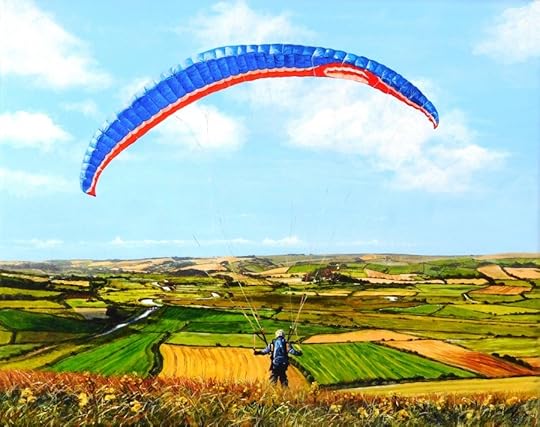
From Caburn to Canopy by Paula Oakley
Here is a good example of how Paula Oakley describes this painting:
“On top of Mount Caburn, on the outskirts of Lewes in Sussex. A paraglider stands among the wild flowers preparing to soar the Summer breeze above the panoramic landscape. Below the River Ouse meanders by the side of Lewes Brooks and the village of Rodmell on its final journey to the sea at Newhaven.”
The artist is creating an atmosphere and a sense of being there. She is also using good keywords that people may be searching for.

I love the way the artist has described this piece:
“‘Brainstorm’ is an original graphite pencil drawing on Stonehenge paper. Highly detailed and realistic, it is a portrait of a thoughtful chimpanzee. His expression is one of deep contemplation as he ponders who knows what. A very characterful image with a hint of humour that would grace any room in the home or workplace. Measuring approximately 10.5 x 16 inches, this drawing is presented in a white mount within a distressed silver gilt frame to a total size of about 18 x 23.5 inches, ready to hang. It is signed on the front and will be accompanied by a certificate of authenticity.”
The artist has included a lot of details not only about the drawing but how it is presented and what you expect to receive with the artwork.
How about abstract art? The same rule applies here, as abstract art could be inspired by anything: from places and flowers to feelings and emotions as well as other forms of art like music for example, or it could be more about the process of creating the work, the spontaneity and how you let the paint take control.
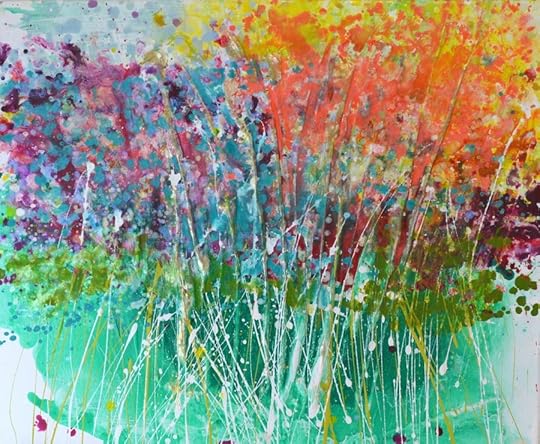
Blooming Sunny by Caroline Ashwood
This particular artist goes into a lot of detail and offers the potential buyer a lot of food for thought:
“New: this is a brand-new series of large abstracts inspired by flowers and gardens. Abstract expressionist artworks on 100% cotton canvas stretched over a wooden frame. No extra framing is required and the painting is ready to hang as soon as you unpack it.
Inspiration: I just love the word ‘blooming’. It is the perfect word to emphasise something. It’s ‘blooming’ cold today, or, it’s ‘blooming’ hot. Also, it’s a ‘blooming’ great replacement for a naughty word. This new series is ‘blooming’ lovely and inspired by spring and summer flowers. I have used lots of sunshiny colours and shimmering metallics in my abstract floral artworks. You can expect quite a few more pieces in this series over the coming months. Something to look forward to while we wait for the warmer weather and the chance to get out and about amongst the real flowers. Over a heavily textured base I applied multiple bright colours with iridescent highlights. The 5cm edges are painted in white I have 15+ year’s experience of shipping artworks worldwide. Your painting will be carefully packaged using high quality thick bubble wrap, corrugated card and an outer double-walled cardboard carton that is very strong for the ultimate protection. UK shipping is free. I can ship worldwide – please just ask for a quote.”
Here not only does the artist explain her inspiration but the title and a little about her process. You understand fully what to expect when you receive the artwork including hanging. There are a lot of keywords in the description ‘flowers’, ‘gardens’, ‘abstract’, ‘summer’ and so forth. This is a really well-thought-out presentation of words.
Add multiple images
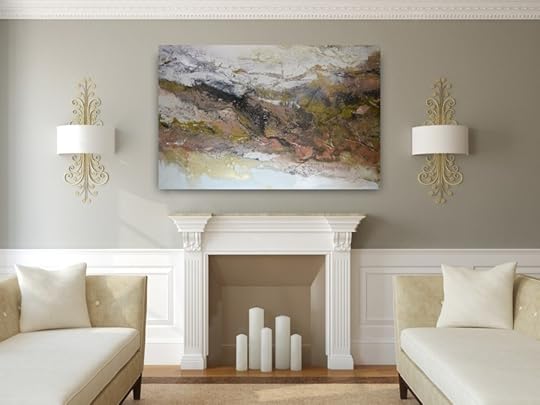
Artwork by Caroline Ashwood
Just one image isn’t enough to really show the work; I would suggest a front cropped image, some close ups, side images and one in-situ. Ensure images are clear and as colour-accurate as possible.
The front image captures the artwork as a whole so people can see what it looks like. But as they can’t actually ‘see’ the artwork in the flesh, the close-ups will show texture, colour and details from your artwork. As such they will have a clearer idea not only of what it looks like, but of your artistic skills as well. Seeing the brushstrokes up close or any other media that you may have incorporated, they will appreciate your technique even more and will get a feel of how much effort you actually put into creating your artwork. You can also include a work-in-progress image so it will have an authentic feel to it.

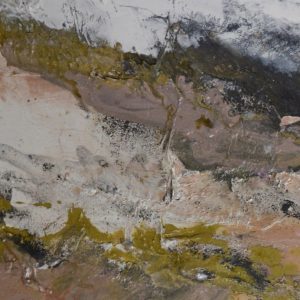
It may also be a good idea to add in-situ images and these could be anything from the artwork on the easel in your studio to how it looks like in a home décor setting. Not everybody can imagine what an artwork will look like on the wall, so adding such a picture will help them visualise the painting in their own home.
‘About me’ section
When you set up your profile online, make sure you complete the ‘About Me’ section as well. Here you have the chance to talk in more detail about your inspiration, your media of choice, your successes as an artist as well as something more about you, like other hobbies, interests and pass time activities. People need to get to know the person behind the paintings so they have the feeling they ‘talk’ to a real human.
One thing that I would suggest is to write about you in the first person. You can include third person paragraphs as well if these are written by someone who knows you and your art like an art critic, a gallery owner or an exhibition organiser. Writing in first person makes it more personal as though you are speaking to your prospective buyer. Add feedback from the customers as well so you’ll add credibility to your profile. You want to be perceived as authentic, trustworthy and skilful and it is entirely up to you to sell yourself and your art to the world.
To read some good examples of artists biographies please see:
Artist Caroline Ashwood
Artist Irina Rumyantseva
Artist Veronica Vilsan
Social media
Don’t forget social media. I know from experience that artists prefer to create and not to talk about themselves but sharing your work on social media could be another ‘ingredient’ needed to sell your work. Again, not just images sell, but words too so try to talk to your audience and be engaging. This may come easier than you think as you don’t have to talk in person. Be friendly and approachable in your tone and invite people to comment and ask questions.
Examples of some of our facebook posts:
I hope you’ll find these tips useful and please let us know- what do you do to sell your art with words?
Michelle Gibbs
www.art2arts.co.uk
The post How to Sell Your Artwork With Words and Images appeared first on Online Marketing for Artists.
March 22, 2019
Member of the Week: Drica Lobo
This week’s featured Association member is Drica Lobo.
TAA: How would you describe your art to your ideal collector?
Drica: I transform California landscapes into a bold, joyful and powerful scenario. Bringing the viewer freedom state of mind and dreamlike state.
 “Looking Up”, Drica Lobo
“Looking Up”, Drica LoboTAA: What motivates you during slow seasons?
Drica: This is where I get to organize my business, putting all the numbers down and plan for the year ahead.
 “In & Out of LA”, Drica Lobo
“In & Out of LA”, Drica LoboTAA: How did you settle on your current way of working? (How did you narrow your focus?)
Drica: It’s hard to say settle, I believe every working artist have a natural outgrowth and creative urge to the new that leads to a more distinct body of work. I narrowed my focus when I found myself painting what resonates to my beliefs and when people were really into buying and loving it my artwork. They both go together. But to get here… it was lots of curiosity, testing materials, painting different subjects, studying artists that I enjoyed looking at it (thanks to Social media, it’s so easy to find what type of work you like). It’s usually what you should be painting, but in your own unique way.
 “Moonlight Over the Industries”, Drica Lobo
“Moonlight Over the Industries”, Drica LoboTAA: What is one mistake you’ve learned an important lesson from in your business?
Drica: Don’t compare yourself with anyone. The more you compare, the more you procrastinate to follow your own path as an artist. Also, don’t listen to people who don’t believe in you.
 “Tidal Forces”, Drica Lobo
“Tidal Forces”, Drica LoboTAA: What was your greatest success from the past year?
Drica: Becoming a full time working artist and having a successful solo show with 200 people and 14 sales on opening night. It was a big year for me.

Drica Lobo is an artist whose work captures happiness and vibrant strokes. Drica’s fascination with art began as a small child. She was born in Sao Paulo, Brazil, moved to the United States in 2003, and made Hermosa Beach, CA her home in 2007. Largely self- taught, Lobo has taken several painting classes during 15 years where she has studied with celebrated artists including Jose Ismael and Lisa Schultz. She completed her Master of Communications Degree at the University of Guarulhos, Sao Paulo in 2001.
Drica Lobo currently lives and works in Hermosa Beach. Her work is included in public and private collections around the world, including Brazil, United States, Singapore and China. She is a member of Hermosa Beach Artist Collective (HBCA) and Foundation of Local Arts (FOLA) in California.
The post Member of the Week: Drica Lobo appeared first on Online Marketing for Artists.
March 20, 2019
Passive Income for Artists
Branching out in your art business from the primary revenue streams of sales of originals and prints can be a very smart move. It’s all about diversifying your income so that if one gallery dries up, you can still count on money coming in. When setting up passive income streams like print-on-demand products and the other items on this list, it’s important to remember that they can take quite some time to establish and begin bringing in any substantial extra income. For an extremely helpful look at the inner workings of a successful print business, check out our interview on managing a successful print studio with artist Patricia Vargas.

This list of ways to bring in passive income for artists is in part the culmination of a conversation with successful professional artists in our Association. This can be especially helpful for artists whose primary work is very time-consuming and who may therefore go long periods between new projects. Use this list as a starting point to inspire you to get creative with your own business and find new ways to bring in passive income to help you not just keep your business afloat, but thriving!
Passive Income for Artists
Sell instructional videos. Hundreds, if not thousands, of artists are successfully selling their “secrets” online by creating tutorial videos and selling them as lessons, either individually or in bundles. Use YouTube to share and generate interest in your work, then point fans to your website to purchase access to your tutorials. For a list of ways to start selling online art courses, check out our post on how to make money teaching art online.
Sell instructional ebooks. In a similar vein, you can compile your techniques and knowledge into an ebook and sell it through your website, Amazon, or even through teaching platforms like Skillshare and Udemy.
Create a coffee table book of your art. Once you’ve assembled a substantial portfolio, consider putting your work together into an attractive coffee-table book. You can create one online through a print-on-demand service like Shutterfly or Snapfish, or go with a local printer.
Sell print-on-demand merchandise with your art on it. This is the option that most artists default to when considering alternate and mostly-passive revenue streams. Be aware that it can take quite some time for any considerate income to accumulate from this method. As with selling your originals, you’ll see a better return on this if you leverage the help of influencers to spread the word about your work. (For a long list of the top print-on-demand websites, check out our Member Library.) Here are just some of the products you can put your artwork on:
mugs
calendars
journals
stationery
clothing
bedding
phone cases
bags
stickers
posters
Create a subscription service and take payments for previews of new work, WIP videos, wallpaper downloads, exclusive videos, etc. (this isn’t necessarily passive all the time). A common platform for this kind of endeavor is Patreon, but you can also take payments on your own site. For some inspiration, check out the what the top-earning artists on Patreon are doing.
Licensing is one of the ultimate passive income options, but it’s a very different beast from selling your art the conventional way. If you choose to go this route it will require a lot of work and research. Check out our interview with Tara Reed on how to license your art.
Creating a passive income stream can be a lot of work up front, and may even require a monetary investment. If you’re considering adding passive income to your business, you’ll need to take the time to research which option is best for you. Generally speaking, the correct option is the one you’re willing to stick with for the long haul, because passive income can take quite some time to get rolling. But if you’re willing to put in the work and stick with it, you’ll probably be very glad that you did!
How do you bring in passive income for your art business? Did we leave anything out? Let us know in the comments!
The post Passive Income for Artists appeared first on Online Marketing for Artists.
March 15, 2019
Member of the Week: Marianne Goodell
This week’s featured Association member is Marianne Goodell.
TAA: How would you describe your art to your ideal collector?
Marianne: Figurative, symbolic art and jewelry for personal reflection and emotional release.
 “The Path”, Marianne Goodell
“The Path”, Marianne Goodell
TAA: What motivates you during slow seasons?
Marianne: Trying new techniques, taking courses, watching YouTube videos by other artists.
 “Egyptian god Osiris enamel pendant”, Marianne Goodell
“Egyptian god Osiris enamel pendant”, Marianne Goodell
TAA: How did you settle on your current way of working? (How did you narrow your focus?)
Marianna: The busier I got, the more I had to decide what it was I really wanted to do. What do I love doing?
 “Pisces”, Marianne Goodell
“Pisces”, Marianne Goodell
TAA: What is one mistake you’ve learned an important lesson from in your business?
Marianne: To quit selling myself short. I make an assumption people can’t afford my art, so I have a tendency price too low. I’m stopping myself from doing that when quoting prices.
 “Charoite framed in silver”, Marianne Goodell
“Charoite framed in silver”, Marianne Goodell
TAA: What was your greatest success from the past year?
Marianne: New clients, FB likes over 3K, exceeded sales goals, created online co-op with other artists who want to grow their business.

Marianne Goodell creates archetypical emotional figurative art and jewelry infused with symbols and animals. Invoking healing and growth is one of the main focuses of her work, and she hopes you can be inspired to grow and heal as well. The intention is to elicit a reflective response to heal. Every piece pours out of her heart with the intention of significant meaning. See more of Marianne’s work at her website: http://mariannegoodell.com
The post Member of the Week: Marianne Goodell appeared first on Online Marketing for Artists.
March 13, 2019
Exclusivity in Artist Contracts
Exclusivity, in a contract with a client who is requesting a custom piece, prevents the artist from creating and/or selling reproductions of the original work. In other words, you paint a piece, the client pays you, you transfer ownership of the piece to the client, and you can’t sell prints of that piece. Depending on the way your contract or agreement is worded, exclusivity may transfer ownership of not just the actual piece of artwork, but and all associated rights (the intellectual property) to the client as well. While not always the wrong choice, this is something to be very wary of.
Exclusivity is a pretty big ask, and you may find it with large corporate clients, especially if you’re an illustrator working with an existing intellectual property. If you agree to exclusivity without realizing it, and then breach that agreement by selling prints or reproductions of the work, you could find yourself faced with litigation. It’s normal and expected for an artist to retain all the rights to reproduce their work and profit from sales of prints and reproductions as well as use images of the work in their marketing. If the contract you’re signing prohibits this, it’s extremely important that you’re aware of it in advance.

Wording that may indicate exclusivity
Wording that indicates it’s transferring copyright to the client, that the client will become the owner of the intellectual property, or wording that asks the artist to agree that they will not sell any prints or reproductions of the piece all indicate a form of exclusivity. If you’re unsure about what the wording indicates, ask the client for clarification, or get some legal advice.
When is it acceptable for a client to request exclusivity?
This is up to you, but if print sales make up any part of your business model you’ll need to be compensated for the potential loss of income by increasing the price of the piece by a factor of two or three.
When should you refuse a request of exclusivity?
There are a few cases when you should definitely not agree to exclusivity:
If you’re not comfortable with signing away your right to create prints of the piece and sell them. If you can’t reconcile your personal values and your business model with the notion, then don’t agree to it. You can either ask to have that section of the agreement removed, or very kindly recommend that the client find another artist. You have the right to do this.
When the amount offered does not reflect the artist’s potential losses. Exclusivity must drive the price of the work up, not because it increases the value of the original (this is a fallacy) but because it must account for the artist’s potential losses. If you can’t sell prints and make a profit from them, you’re losing potential income, and the price the client pays must reflect that. Generally speaking, the price should be two to three times what it would be without exclusivity.
Exclusivity is not something to be afraid of, and just because you see the wording in a contract or agreement doesn’t mean you need to automatically refuse it. But you should be aware of what it means for you and your business, and ensure that you are in full agreement with the client to that end. You should also ensure that the price you receive for the piece also includes the price of the intellectual property, which is extremely valuable.
Have you ever entered into a contract that allowed the client to retain the intellectual property along with the finished original? What was the experience like for you? Let us know in the comments!
Extra resources
Association members have access to the recording and transcript for Negotiation Tactics for Women on our Association Call Archive page next to October 23, which will help you to more confidently negotiate your contracts.
Check out Kiffanie Stahle’s awesome resources over at the artist’s J.D. (Association members can also check out our legal clinic with her over on our Association Call Archive page next to November 29.)
The post Exclusivity in Artist Contracts appeared first on Online Marketing for Artists.
March 8, 2019
Member of the Week: Taylor Ann, Painting the Fragility and Beauty of Life
This week’s featured Association member is Taylor Ann.
TAA: How would you describe your art to your ideal collector?
Taylor: My work is the representation of what we, at times, forget about. The life we share our planet with. The variety of animals that is on this blue planet is truly amazing. All wildlife we can and should learn from. The creatures that are my subjects show us the fragility of life, the beauty that is across the globe, and the reminder that conservation benefits all of us. It’s no secret that the world is fragile and our decisions with things affect everything over time. It’s time to stop and remind ourselves that change is possible. It starts with a whisper of urgency and grows to a scream. My way of creating that scream is by visually showing you what all is at risk of disappearing for good. After all, this is the only planet we got.
 “Safety”, Taylor Ann
“Safety”, Taylor Ann
TAA: What motivates you during slow seasons?
Taylor: Slow seasons are a great time for me to experiment. This could be in forms of a new subject, new composition, or new mediums. Some of my best discoveries of myself have happened during the slow season. To say I don’t get in a negative mindset would be a lie. I have many moments of feeling like a failure because I am experiencing a slow time in my career. When those shadows approach, I remind myself how much I loved creating as a child. How that helped me push past difficult times, express myself without using words, as well as realizing my truth. Sometimes, it takes some effort but in the end I come out stronger.
TAA: How did you settle on your current way of working? (How did you narrow your focus?)
Taylor: It took me a while to figure out my path. Even longer to realize that it will most likely change as time goes on. When I set a schedule for myself is when I really start to flourish. I made a calendar of the week with each day dedicated to a specific task. Allowing for other options. For example, if I had to prepare for a show, I would allow some more time to finish the series on typical marketing days. For me, listening to podcast is helpful for focus as well as lo fi hip hop (mellow beats). I also put a reminder that there will be days when I can’t stick to that schedule, and that’s okay too.
In regards to working on my craft, I experimented with other styles off and on. I’ve always had a love and appreciation for high detail in art. When I focused more on taking my time with this detail, I really felt that artistic groove take hold in each project.
 “In Need of Rest”, Taylor Ann
“In Need of Rest”, Taylor Ann
TAA: What is one mistake you’ve learned an important lesson from in your business?
Taylor: Take the money up front! You make this mistake one time. Especially when this comes to commissions. Just because you are doing a piece for a friend or family member doesn’t mean they shouldn’t pay you up front. That phrase “I’ll get you back soon” never leaves my mind, mainly because they never did “get me back”. This mistake was made early on. I am grateful it only took one time.
 “Curiosity”, Taylor Ann
“Curiosity”, Taylor AnnTAA: What was your greatest success from the past year?
Taylor: 2018 has been a very difficult year for me, personally. Too much loss through the year with battles to fight in between. Through all of it, as simple as it sounds, my greatest success was I didn’t let all of those hard times defeat me. I licked my wounds, felt the pain, cried a lot, cursed every minute, and allowed for the rest needed to heal me so I could continue. I made a promise to myself many years ago, I will not let trauma or difficult times destroy me. I will pause to heal and process. But I will not just stop doing what I want because life is far too short to throw in the towel.

Taylor was born in January of 1989 in Warren, MI. In 1995, she moved out to Las Vegas, NV with her mother. The discovery of art lined up with her discovery of wildlife in many ways. Over time, she started researching ways to put her love of wildlife art to work with helping wildlife conservation.
As of April 2013, she has had the honor of working with Safe Haven Wildlife Sanctuary in Imlay, NV. Wildlife protection is extremely important in her work and being able to be involved with an organization that saves neglected and abused animals is a true honor. There are currently pieces displayed on site at Safe Haven. Pieces have sold to supporters of their cause since April of 2013. In the spring of 2015, she also partnered with WildCat Ridge Sanctuary to also help support their residents with her work. See more of Taylor’s work at http://wildlifeartbytaylor.com
The post Member of the Week: Taylor Ann, Painting the Fragility and Beauty of Life appeared first on Online Marketing for Artists.
March 1, 2019
Member of the Week: Bart Levy, Impressionist Scenes of Beauty
This week’s featured Association member is Bart Levy.
TAA: How would you describe your art to your ideal collector?
Bart: Impressionist/expressionist, affordable, scenes and objects of beauty.
 “Yellow Sunset”, Bart Levy
“Yellow Sunset”, Bart Levy
TAA: What motivates you during slow seasons?
Bart: Currently, my 100 paintings in 100 days project. Even when I might otherwise find excuses for not going to the studio, my very public announcement and follow-up keep me going every day. And I’m always glad to be back at it, every day.
 “Moon Rise Sun Rise”, Bart Levy
“Moon Rise Sun Rise”, Bart Levy
TAA: How did you settle on your current way of working? (How did you narrow your focus?)
Bart: I’m a somewhat literal-minded person, so I paint what I see. I like capturing the moment.
 “Edge of the Woods”, Bart Levy
“Edge of the Woods”, Bart Levy
TAA: What is one mistake you’ve learned an important lesson from in your business?
Bart: I’m still new at the business end of it, but I think my biggest mistake is my own impatience. I’m getting a lot of nice feedback, but few sales.
 “Ranunculas and Azaleas”, Bart Levy
“Ranunculas and Azaleas”, Bart Levy
TAA: What was your greatest success from the past year?
Bart: I’m getting some nice PR from the 100 paintings/100 days project. I’m hoping it turns into some of the bigger sales I mentioned above.
 “Seeing Red”, Bart Levy
“Seeing Red”, Bart Levy
 Bart Levy’s painting style is somewhat impressionistic, somewhat expressionistic. She captures the openness of the landscape. The rural landscape in Virginia and North Carolina is emptying out. She captures that loneliness of the wide open fields and skies.
Bart Levy’s painting style is somewhat impressionistic, somewhat expressionistic. She captures the openness of the landscape. The rural landscape in Virginia and North Carolina is emptying out. She captures that loneliness of the wide open fields and skies.
The land is flat. No grand vistas, no scenic overlooks. The view is all overhead and that continues to influence my landscapes to this day. She likes to try to capture the infinite qualities of a blue sky, the effect of that big sky and the heat and humidity it creates, and the always-changing clouds. By the same token, she captures the beauty around us, both in the intimate still life and in her surroundings. You can see more of her work at http://bartlevyart.com
The post Member of the Week: Bart Levy, Impressionist Scenes of Beauty appeared first on Online Marketing for Artists.
February 27, 2019
What’s the Difference Between an Art Show and a Craft Fair?
What’s the difference between an art show and a craft fair? Why is it so important?
Identifying the differences between the two types of shows isn’t about making a value judgment or asserting that one is better than the other. On the contrary, they can both be fun, great for networking and attracting new customers, and incredibly lucrative for your business. It’s all about finding the right match for your artwork.
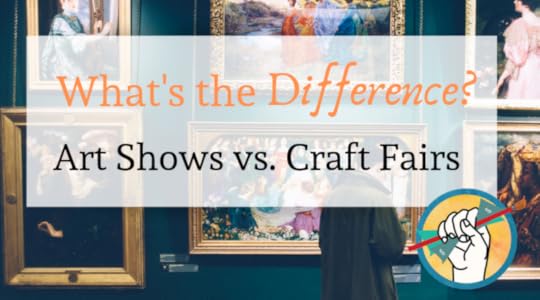
The risks of choosing the wrong kind of art show
Show your work at the wrong kind of exhibition and you’re going to waste a lot of time, effort, and money. This can lead to pretty severe demoralization. It can be hard to bounce back from a bad show if you’re not surrounded by a helpful community of supportive fellow artists. And this is assuming the art show is still a decent one. (P.S. The risks are different if the art show itself is poorly run: Is an Art Show Ever a Bad Idea?)
One distinction to make at the outset is that a craft fair doesn’t imply a lower degree of skill. On the contrary, at craft fairs you’re likely to find artists who have been honing their craft for decades and work at a very high degree of skill. As former MoMA associate curator Mildred Constantine put it, ”Craft is the mastery of techniques and materials; art is the investment of spirit in whatever materials are used”. Do you prefer to focus on honing your mastery of techniques and materials and feel less adamant about the message, or do you have a burning vision to share with the world, and care perhaps slightly less about the medium that carries it? You may be somewhere between these two on the spectrum; it’s simply a way to begin thinking about where your work fits into the larger art world. (You can, of course, have a coherent story to tell your collectors either way.)
The difference between art shows and craft fairs
Art Shows
Craft Fairs/Bazaars
Potentially higher cost of entry
Often lower registration fees and booth fees
More likely to be juried/curated or require that artists have gallery representation
Low or no barriers to entry
Fine art paintings/drawings, sculpture, etc.
Arts and crafts including paintings and sculpture but also jewelry, textile crafts, foods, etc.
Less likely to allow other vendors besides artists
May allow direct sales, antiques, and other types of vendors
Attracts collectors
Attracts shoppers
Exhibition around a particular theme
No theme, or the theme may be a holiday
If your work seems to fall somewhere between the categories, that’s okay! You can decide where your art fits best by asking yourself some strategic questions:
What does your body of work look like?
How do you talk about your work?
What’s your vision for the future of your work?
Where do you want your work to be that it isn’t yet?
Do you sometimes translate a common theme across different mediums?
How far along in your career are you?
How much do you sell your work for?
Do you take commissions?
Whether you decide to apply to a juried art show or an annual Christmas craft fair, it’s important to ask some other questions about your readiness and the quality of the show. You can find a list of those questions here: Should You Exhibit in That Art Show? 10 Questions to Ask
How did you come to realize where your artwork fits, between fine art shows and craft fairs? Let us know in the comments!
The post What’s the Difference Between an Art Show and a Craft Fair? appeared first on Online Marketing for Artists.
February 22, 2019
Member of the Week: Chelsea Lang, Painting the Joy & Light of the Outdoors
This week’s featured Association member is Chelsea Lang.
TAA: How would you describe your art to your ideal collector?
Chelsea: My work is about bringing the joy and light of the outdoors into your home.
 “Veil”, Chelsea Lang
“Veil”, Chelsea Lang
TAA: What motivates you during slow seasons?
Chelsea: During slow seasons I rely on a stock of reference images I’ve compiled. It’s not immediate, but once I’m willing to try one of these paintings they really do help – particularly if I’m juggling some commission work, which can be fairly draining.
 “Waterfall”, Chelsea Lang
“Waterfall”, Chelsea Lang
TAA: How did you settle on your current way of working? (How did you narrow your focus?)
Chelsea: I narrowed my focus by looking at all of the art styles that I admired and asking which I would be most proud to identify with. I love a wide range of styles, but this was a breakthrough for me. As for subject matter, I’ve relied on mentors to encourage me to try things that they’ve found connect better with collectors.
 “Chocolate Palomino”, Chelsea Lang
“Chocolate Palomino”, Chelsea Lang
TAA: What is one mistake you’ve learned an important lesson from in your business?
Chelsea: If you build it they will NOT come. You cannot hide behind an online presence where you simply post work and wait for success. You need to go out in person, meet people, and start sharing yourself with them.
 “Untitled Portrait”, Chelsea Lang
“Untitled Portrait”, Chelsea Lang
TAA: What was your greatest success from the past year?
Chelsea: My greatest success from the past year was my first show, a pop-up at a local group studio space, where I got $1100 in sales, and sold some of my first originals that were made just for me – not as a commission.
 CHELSEA LANG is a fine artist and illustrator working out of Raleigh, North Carolina whose work explores the beauty of light and the human form. You can see more of her work at http://chelsealang.com
CHELSEA LANG is a fine artist and illustrator working out of Raleigh, North Carolina whose work explores the beauty of light and the human form. You can see more of her work at http://chelsealang.com
The post Member of the Week: Chelsea Lang, Painting the Joy & Light of the Outdoors appeared first on Online Marketing for Artists.
February 20, 2019
Is an Art Show Ever a Bad Idea?
How do you know if that art show is going to be worth your time and money, or if it’s going to be a total dud and a drain on your resources? Doing ample homework ahead of time will reduce any anxiety you may feel about whether the show is going to work out in your favor. Here are some signs that your art show experience may not turn out as you hope. If you check off too many of these boxes, you may want to reconsider exhibiting in the show and wait until either you’re better prepared or a better show comes along.
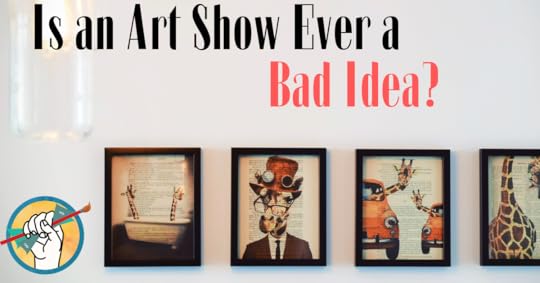
Signs Your Business is Not Ready for an Art Show
You don’t know how to communicate your message or vision yet. You need to know how to tell your story in a compelling way. Not sure how to do this? Learn how to create raving fans by telling the story of your art.
You don’t have at least 10 original pieces ready to sell.
You don’t have a consistent series to show. A body of work with a consistent theme/style is extremely important. Find out why you need to create work in a series.
You haven’t nailed down your pricing. Lay the groundwork for a successful show with solid pricing that reflects your value. Here’s more on how to price your art.
Signs an Art Show May Be a Bad Fit For You
All the other exhibiting artists are high above or below your experience level (and it shows). A casual Christmas arts & crafts bazaar won’t be a good fit for you if you’re looking to show in national galleries. It can, however, be a great and less intimidating start for a new artist without much experience showing or selling.
The theme or medium doesn’t match your work. Read more about how to find out if an art show is a good match for your work.
The show is very expensive and you’re on a limited budget. There are quite a few hidden costs associated with showing your art. Make sure you know how much an art show is going to cost you, and whether you can afford it. If you’re going to take a gamble on an expensive show, you need to be well aware in advance that you are taking a risk, and plan accordingly.
Signs the Art Show May Be a Dud
They’re not advertising much or at all. A good show doesn’t just advertise- they advertise to the right audience.
They don’t support exhibiting artists. A good show will have ample communication, a clear method of transacting sales, a clear explanation of what they provide vs. what you’re expected to provide. They may or may not take a commission on artists’s sales, but whether or not they do should be clear ahead of time.
They’re brand new and nobody knows about them yet. On its own, this isn’t necessarily a bad sign. Every show has to start somewhere. But seasoned artists who are very selective about the shows they choose to attend tend to avoid new shows until they’ve found their feet.
The gossip isn’t good. Ask around in person and online: does the show seem to carry a high amount of drama? Do too many artists have horror stories of bad experiences with the show?
Setting a clear expectation for yourself from the very beginning of an art show will ensure that you don’t waste your precious time or money on a dud. Once you’ve decided that a show is a good fit for you, make sure you understand the basics of salesmanship like confident body language and active listening.
Have you ever attended a show that turned out to be a dud? What did you learn from the experience? We want to hear your stories, so let us know in the comments!
The post Is an Art Show Ever a Bad Idea? appeared first on Online Marketing for Artists.
The Abundant Artist Goodreads blog
- Cory Huff's profile
- 31 followers



